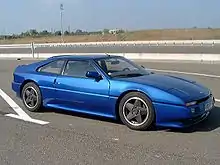Venturi Atlantique
The Venturi Atlantique was a mid-engined, fiberglass-bodied French sports car produced by Venturi Automobiles from 1991 to 2000.
| Venturi Atlantique | |
|---|---|
 Venturi 300 Atlantique | |
| Overview | |
| Manufacturer | Venturi Automobiles |
| Production | 1991-2000 |
| Assembly | Couëron, Pays de la Loire, France |
| Designer | Claude Poiraud, Gérard Godfroy |
| Body and chassis | |
| Class | Sports car |
| Body style | 2-door coupe |
| Layout | mid-engine, rear-wheel drive |
| Powertrain | |
| Engine | 2.8L PSA PRV V6 turbo 3.0L PSA ES V6 N/A, turbo or biturbo |
| Transmission | 5-speed manual transmission |
Atlantique 260

The original 260 was a revised version of the Venturi APC 260, carrying over the 2.8L turbocharged V6 engine with 260 hp (194 kW; 264 PS), but with a reduced weight of 1,110 kg (2,450 lb). It was good for a top speed of 167 mph (269 km/h) and accelerated from 0-60 mph (97 km/h) in 5.2 seconds.
Atlantique 300
Scotsman Hubert O'Neill purchased Venturi in 1994 and conceived of the Venturi 400GT as well as a revised Atlantique. After a rushed design time of six months, the new Atlantique 300 was unveiled at the Paris Motor Show. Its 3.0 V6 PRV engine was lifted from other Peugeot/Citroën models and was good for 210 hp (157 kW; 213 PS) in naturally aspirated form or 281 hp (210 kW; 285 PS) with a turbocharger which was essentially the same engine as used in the Alpine A610.
Venturi again went into receivership in 1996, and was bought by Thai firm Nakarin Benz, under whom the company focused its concentration upon road cars.
Atlantique 300 Biturbo
The Twin-turbo version of the Atlantique 300 was released in 1998 and used the later L7X V6, a Renault variant of the V6 ESL engine which brought the power up to 310 PS (228 kW; 306 hp) at 6,200 rpm and 394 N⋅m (291 lb⋅ft) of torque at 3,800 rpm, with a top speed of 275 km/h (171 mph) and a 0-100 km/h (62 mph) time of 4.7 seconds,[1] this addition made the Atlantique a serious performance competitor to the Lotus Esprit V8. 13 examples were built in 1999-2000; this model was the last Venturi to be considered 'French', before the firm became based in Monaco.
Venturi 300 GTR
In 1999, 2 cars were built exclusively for track racing. They were designated Venturi 300 GTR.
Reception and fate

Sales of the Atlantique were extremely poor; total Venturi sales over its lifespan amounted to fewer than 700, despite praise from contemporary critics and from Top Gear. In a 1992 episode, Jeremy Clarkson noted that the two most exciting sports cars of the time were the Alpine A610 and the Venturi Atlantique, and that the Atlantique was "like having your own personal jet fighter [...] I love it to death." In comparing the biturbo Atlantique and the Lotus Esprit, Performance Car noted that the Atlantique was "[...] a more relaxing car to drive, its tidier dimensions make it easier to place, it rides more smoothly, generates far less road noise, and has a much slicker gearchange. It's better built too."
Venturi again faced bankruptcy in 2000, and the Atlantique went out of production. Although current owner Gildo Pallanca Pastor, a Monegasque millionaire, has resumed production of Venturi cars, he has shifted the emphasis to electric sports cars such as the Venturi Fétish, retiring the Atlantique badge. Company production will be even more limited at 10 units per year.
References
- Sébastien Dupuis (ed.). "VENTURI ATLANTIQUE-300 (1996 - 2000)". automobile-sportive.com (in French). Retrieved June 18, 2018.